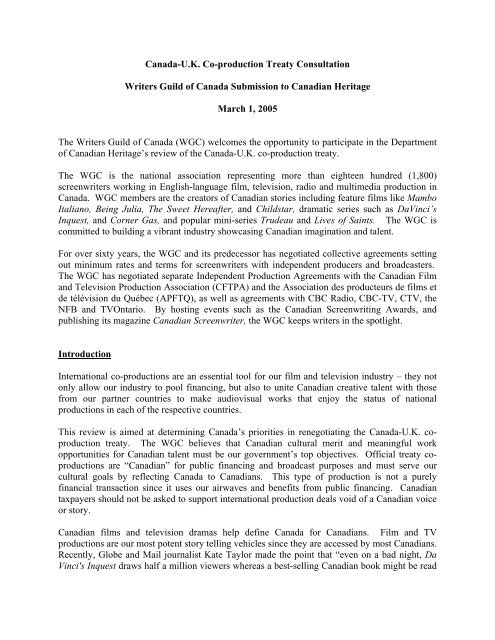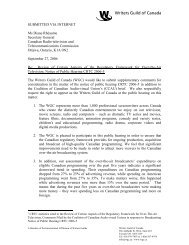UK-Canada Co-production Treaty Consultation - Writers Guild of ...
UK-Canada Co-production Treaty Consultation - Writers Guild of ...
UK-Canada Co-production Treaty Consultation - Writers Guild of ...
You also want an ePaper? Increase the reach of your titles
YUMPU automatically turns print PDFs into web optimized ePapers that Google loves.
WGC submission re: U.K.-<strong>Canada</strong> <strong>Co</strong>-<strong>production</strong> <strong>Treaty</strong>, March 1, 2005 Page 2 <strong>of</strong> 8by 20,000 Canadians and no Canadian play would be seen by more than a few thousand. 1 ”Clearly, we should be putting our limited resources behind our own culturally relevant films anddramas; hard-earned taxpayer support should not be wasted telling other people’s stories.<strong>Canada</strong>-U.K. co-<strong>production</strong> treatyThe <strong>Canada</strong>-U.K. co-<strong>production</strong> treaty has been our most successful in terms <strong>of</strong> <strong>production</strong>volumes, and the most active partnership for both countries. In 2003, <strong>Canada</strong> represented 57%<strong>of</strong> <strong>UK</strong>-bilateral co-<strong>production</strong>s and 30% <strong>of</strong> all co-<strong>production</strong>s. In the same year, the U.K.represented 33% <strong>of</strong> <strong>Canada</strong>’s bilateral co-<strong>production</strong>s and 39% overall. More recently however,volume <strong>of</strong> activity has constricted under the treaty and is expected to drop further.This decline is largely attributed to the U.K.’s new expenditure rules that took effect on January5, 2004 for projects coming under the <strong>UK</strong>/<strong>Canada</strong> treaty. The new rules replace the formerminimum 20% financial contribution for each <strong>of</strong> the co-<strong>production</strong> partners, implementing aminimum 40% spend on <strong>UK</strong> facilities and personnel for bilateral co-<strong>production</strong>s. Where there isa third co-producer a 35% <strong>UK</strong>-spend requirement applies, and for projects with four or more co<strong>production</strong>partners, a minimum 30% <strong>UK</strong> spend applies.More Canadian broadcaster and distributor investment is neededAs the U.K. and our other co-<strong>production</strong> partners implement rules designed to protect theirculture and maximize the use <strong>of</strong> their creative talent, Canadian producers find it increasinglydifficult to close the funding gap for national projects. The main problem is the lack <strong>of</strong> Canadianprivate investment in Canadian film and television <strong>production</strong>s. While our private broadcastersand distributors benefit greatly from the protected Canadian market and reap substantial pr<strong>of</strong>its,they financially contribute the bare regulated minimum to Canadian dramatic <strong>production</strong>s.Canadian private conventional broadcasters spend four times more on U.S. programming thanCanadian, and in 2004 they spent 13% less on Canadian drama than in 2003 2 . Canadiandistributors also reduced their financial contribution to CAVCO-certified theatrical <strong>production</strong> toonly 10% last year, and Telefilm figures show that they contributed only 4.5% <strong>of</strong> <strong>production</strong>budgets for supported English language films in 2003/04.This is unacceptable. The WGC urges the government to direct the CRTC to review its 1999Television policy which removed requirements from private conventional broadcasters tosupport dramatic features and television series. A new Canadian Television Policy must includedrama-specific expenditure and exhibition requirements to ensure private broadcaster investmentin the development and <strong>production</strong> <strong>of</strong> high-quality drama. Telefilm’s rules governing distributorsupport must also be revised to ensure that public support for distributors is contingent on theirincreased investment in the <strong>production</strong> <strong>of</strong> Canadian theatrical features.1 Kate Taylor, “Shows like Eleventh Hour beat bestsellers,” Globe and Mail, February 26, 2005, page R6.2 CRTC Television, Statistical and Financial Summaries 2004.
WGC submission re: U.K.-<strong>Canada</strong> <strong>Co</strong>-<strong>production</strong> <strong>Treaty</strong>, March 1, 2005 Page 3 <strong>of</strong> 8Projects void <strong>of</strong> a Canadian voice do not deserve public supportThe paucity <strong>of</strong> private investment means that Canadian projects increasingly rely on publicsupport to get made and it is our government’s responsibility to ensure that Canadian taxpayersget value for their investment.The WGC believes that publicly supported co-<strong>production</strong>s should not be purely financialtransactions – they should have cultural merit and reflect <strong>Canada</strong> to Canadians. In order for<strong>of</strong>ficial treaty co-<strong>production</strong>s to have a Canadian voice, at a minimum Canadians must occupyone <strong>of</strong> the key creative positions <strong>of</strong> screenwriter or director. Unless this minimum requirement ismet, co-<strong>production</strong>s are no different than foreign-service <strong>production</strong> created elsewhere but using<strong>Canada</strong> as a shooting location.Currently, a very low percentage <strong>of</strong> <strong>of</strong>ficial Canadian co-<strong>production</strong>s are written by Canadianpr<strong>of</strong>essional screenwriters. Of the 200 <strong>of</strong>ficial <strong>Canada</strong>-U.K. co-<strong>production</strong>s made from 2000-2004, only 14% or 28 <strong>production</strong>s were written under WGC contracts. Statistical analysis <strong>of</strong>other prominent Canadian co-<strong>production</strong> partners bears similar data. From 2000-2004, therewere 185 <strong>of</strong>ficial <strong>Canada</strong>-France co-<strong>production</strong>s while only 12.5% or 23 <strong>production</strong>s werewritten by WGC members, in the same period only one <strong>of</strong> seventeen <strong>Canada</strong>-Germany projectsand only one <strong>of</strong> six <strong>Canada</strong>-South Africa co-<strong>production</strong>s were written by a WGC pr<strong>of</strong>essionalscreenwriter. Clearly, there is room for improvement.English <strong>Canada</strong> should learn by the positive examples <strong>of</strong> other successful jurisdictions thatchoose to support and encourage projects with cultural merit, rather than trading <strong>of</strong>f creativetalent to attract foreign financing. Examples include the U.K., other European jurisdictions andAustralia who have implemented legislation to protect and support their culturally relevant,domestic stories and are being rewarded by higher domestic audiences for their national film andtelevision works. Closer to home, the successful Quebec television and film industry hasachieved both financial and critical success based on local stories told from a uniquelyQuebecois perspective, written, directed and performed by Canadian talent.It is also important that Canadian airwaves and cinemas are not filled with “Canadian content”that has little or no Canadian creative input. For example, Resident Evil was a 20% Canadianand 80% U.K. financed project that lacked any Canadian cultural merit but was shot in Torontoemploying crews and other support. White Noise, Head in the Clouds, and River King were alsocertified as co-<strong>production</strong>s by Telefilm although they did not tell Canadian stories and were notwritten by a Canadian screenwriter. This type <strong>of</strong> <strong>production</strong> is foreign service <strong>production</strong>. Itshould not receive public money nor be classified as “Canadian” for broadcast and distributionpurposes because it does not include Canadian creative input. These projects may howeverbenefit from tax credits provided by federal and provincial governments for foreign <strong>production</strong>s.CAVCO scale should be used to assess Canadian creative participation<strong>Canada</strong>’s <strong>of</strong>ficial treaty co-<strong>production</strong> agreements require that each partner country’s creativeand technical participation must be proportionate to their financing. While Telefilm isresponsible for gauging Canadian creative participation, it lacks transparent, objectiveassessment criteria.
WGC submission re: U.K.-<strong>Canada</strong> <strong>Co</strong>-<strong>production</strong> <strong>Treaty</strong>, March 1, 2005 Page 4 <strong>of</strong> 8Rather than reinvent the wheel, the WGC recommends that the Canadian Audiovisual OfficeCertification Office (CAVCO) certification process be used to assess <strong>of</strong>ficial treaty co<strong>production</strong>s.This would mean that <strong>of</strong>ficial treaty co-<strong>production</strong>s would be subject to thesame criteria as other projects seeking designation as “Canadian” for public financialsupport and broadcasting purposes. Telefilm staff have confirmed to the WGC that they usethe CAVCO Canadian content scale (based on specific criteria for key creative personnel forboth live-action and animation <strong>production</strong>s using a point value scale) informally as a guide toassess key creative input. The WGC recommends that this process be formalized by requiringthat only co-<strong>production</strong>s earning a minimum <strong>of</strong> 6 points on the CAVCO scale be certified as<strong>of</strong>ficial Canadian projects.By using the widely-used CAVCO system, Telefilm can easily assess whether a project meetsthe 6 out <strong>of</strong> 10 Canadian content points requirements and merits Canadian certification. Allother projects, receiving less than 6 points our <strong>of</strong> 10 but including a Canadian <strong>production</strong> partner,would not be certified as <strong>of</strong>ficial Canadian co-<strong>production</strong>s but would qualify for the federalProduction Services Tax Credit and applicable provincial tax credits.WGC responses to Heritage <strong>Canada</strong> Questions:1. The <strong>UK</strong> has indicated that treaties must stipulate both economic and culturalobjectives and that future co-<strong>production</strong> activity between <strong>Canada</strong> and the <strong>UK</strong> willneed to achieve these objectives effectively. What are some examples <strong>of</strong> bothcultural and economic objectives and how should these be measured?Objective: Publicly-supported co-<strong>production</strong>s should earn at least six out <strong>of</strong> ten CAVCOCanadian content pointsThe WGC recommends that <strong>of</strong>ficial treaty co-<strong>production</strong>s be subject to the same criteria as otherprojects seeking designation as “Canadian” for public financial support and broadcastingpurposes. By using the CAVCO scale, only projects earning a minimum <strong>of</strong> six out <strong>of</strong> ten pointswould be certified as <strong>of</strong>ficial treaty co-<strong>production</strong>s. In this way, our government would ensurethat only projects with meaningful Canadian creative input would enjoy the benefits <strong>of</strong>“Canadian” national <strong>production</strong> designation. Projects earning less than six CAVCO points couldqualify as foreign-service <strong>production</strong> for tax purposes.Our industry calls on Canadian Heritage to fully support Canadian creative talent, not to seekfurther “flexibility” to involve non-Canadian screenwriters and directors in publicly-supportedprojects. We have experienced screenwriters in <strong>Canada</strong> and do not need non-Canadianscreenwriters to write treaty co-<strong>production</strong>s financed by Canadian taxpayers. For example, MyBig Fat Greek Wedding was mid-range budget film that was written by a Canadian, starred aCanadian, was shot in <strong>Canada</strong>, yet it was not financed by a Canadian producer. This was amissed opportunity that should not be repeated. If Canadian screenwriters and other talent aremarginalized in our own treaty co-<strong>production</strong>s, this will ultimately lead to the overall creativeand productive decline <strong>of</strong> our indigenous <strong>production</strong> sector.
WGC submission re: U.K.-<strong>Canada</strong> <strong>Co</strong>-<strong>production</strong> <strong>Treaty</strong>, March 1, 2005 Page 5 <strong>of</strong> 8The WGC further recommends that the government consider strengthening existing CAVCOCanadian content criteria to include only Canadian residents. This recommendation wassupported by Ogilvy Renault in a March 2004 report prepared for Telefilm entitled “Review <strong>of</strong>Certain Regulatory <strong>Co</strong>nstraints in the Canadian Feature Film Industry.” Ogilvy Renaultrecommended the continued use <strong>of</strong> Canadian content criteria to ensure the maximum use <strong>of</strong>Canadian screenwriters and directors on Canadian <strong>of</strong>ficial co-<strong>production</strong>s and feature films asthis is in line with the Canadian feature film policy’s objective to “develop and retain talentedcreators by investing in screenwriting and pr<strong>of</strong>essional development for filmmakers.” The reportfurther recommended that Canadian content rules regarding the use <strong>of</strong> Canadian screenwritersand directors be tightened to require that these positions be held exclusively by Canadianresidents.2. The <strong>UK</strong> has also indicated a desire to enhance co-<strong>production</strong> relationships throughinnovative partnerships that extend beyond <strong>production</strong>, e.g. training, preservation,co-development. What are examples <strong>of</strong> ways <strong>Canada</strong> could cooperate beneficiallywith the <strong>UK</strong>?DevelopmentThe WGC would like to work with Canadian Heritage and Telefilm <strong>Canada</strong> to devise aneffective partnership with the U.K. and/or other co-<strong>production</strong> partners to pool developmentfinancing resources. This type <strong>of</strong> partnership could increase much-needed script and conceptdevelopment financing for pr<strong>of</strong>essional screenwriters to develop <strong>Canada</strong>-U.K. co-<strong>production</strong>projects. However it is important that development funding currently available for Canadianscreenwriters through Telefilm’s <strong>production</strong> financing and Screenwriters Assistance Program bemaintained and not channeled to a co-development project.TrainingThe WGC does not see a need for our government to financially support a training initiative withthe U.K. or any other co-<strong>production</strong> partner.We have the depth <strong>of</strong> scriptwriting talent in <strong>Canada</strong> to create winning projects that will resonatewith audiences. Our successes with co-<strong>production</strong>s including Lives <strong>of</strong> Saints, The Blue Butterflyand I Love Mummy demonstrate that we have the talent to make film and television shows thataudiences want to watch. The WGC represents pr<strong>of</strong>essional, experienced screenwriters who donot require additional training and the plethora <strong>of</strong> quality film schools in this country means thataspiring screenwriters and other creative talent have ample educational opportunities to learntheir craft. However Canadian screenwriters do need more work opportunities to hone theircraft. Practice makes perfect, and Canadian screenwriters can only get better at what they do bydoing it.3. What steps can be taken to improve the distribution <strong>of</strong> <strong>Canada</strong>/<strong>UK</strong> co-<strong>production</strong>s?In no other industry do producers make products just to leave them on shelves unsold, with nomarketing or promotion. While Loblaws would have failed long ago if it followed this strategy,it is a regular occurrence in the Canadian film and television business. Clearly, it is a waste <strong>of</strong>
WGC submission re: U.K.-<strong>Canada</strong> <strong>Co</strong>-<strong>production</strong> <strong>Treaty</strong>, March 1, 2005 Page 6 <strong>of</strong> 8tax payers money to support co-<strong>production</strong>s that are not theatrically released by distributors oraired by broadcasters in all partner countries. All Canadian co-<strong>production</strong> treaties should requirethat all certified projects include a signed distribution agreement with a distributor and/orbroadcaster in each partner country.Theatrical releasesTelefilm requirements that all <strong>production</strong>s with budgets exceeding $1 million include anagreement with a Canadian distribution company should apply to <strong>of</strong>ficial treaty co-<strong>production</strong>s.In line with Telefilm requirements, the distribution agreement must guarantee the project’sCanadian theatrical release within one year <strong>of</strong> its delivery, and provide for appropriate print andadvertising expenditures for marketing purposes.Telefilm distribution and marketing assistance for a co-<strong>production</strong>’s release should also be madecontingent on the distributor’s investment in Canadian theatrical <strong>production</strong> financing.Distributors have dramatically reduced their financial contribution to only 4.5% <strong>of</strong> <strong>production</strong>budgets for supported English language films in 2003/04. In order to increase Canadiandistributor investment in Canadian <strong>production</strong> budgets, the WGC recommends that publicsupport only be extended to those distributors that demonstrate an appropriate level <strong>of</strong>investment in Canadian projects.Television broadcastFinancial data has demonstrated that Canadian conventional broadcasters are making minimalinvestments in Canadian dramatic feature films, television movies and series. As a result, it ismore and more difficult for producers to close financing on Canadian projects. To increasemuch-needed broadcaster investment, the WGC recommends that private conventionalbroadcasters be directed by the CRTC to pay for and provide first and second windows on theirnetworks for Canadian dramatic feature films, television movies and series.This type <strong>of</strong> support can be modelled on systems in place in the U.K., where FilmFour, adivision <strong>of</strong> Channel Four Television, has financed and broadcast about 300 films to date,averaging 20 feature films annually. This will provide both increased private investment thoughthe licence fees paid for Canadian co-<strong>production</strong>s and television broadcast to reach wideraudiences for certified projects.The WGC urges the government to direct the CRTC to review its 1999 Television policy whichremoved requirements from private conventional broadcasters to support dramatic features andtelevision series. A new Canadian Television Policy must include drama-specific expenditureand exhibition requirements to ensure appropriate private broadcaster investment in thedevelopment and <strong>production</strong> <strong>of</strong> high-quality co-<strong>production</strong> dramas.
WGC submission re: U.K.-<strong>Canada</strong> <strong>Co</strong>-<strong>production</strong> <strong>Treaty</strong>, March 1, 2005 Page 7 <strong>of</strong> 84. What degree <strong>of</strong> key creative flexibility should be allowed with respect to third-partyparticipation in a co-<strong>production</strong>? What criteria could be used to frame suchflexibility?The WGC does not support any flexibility in <strong>of</strong>ficial treaty co-<strong>production</strong>s to allow third countryparticipation. All Canadian certified co-<strong>production</strong>s should be made using creative and technicaltalent exclusively from co-<strong>production</strong> partners.U.S. financing does not make Canadian storiesIn <strong>Canada</strong>, “third-party” participation mostly refers to U.S. financial investment and this is nodifferent than foreign-service <strong>production</strong>. This type <strong>of</strong> <strong>production</strong> does not qualify as <strong>of</strong>ficialtreaty co-<strong>production</strong> because creative control is held by U.S. financiers who insist on havingAmerican screenwriters create and write projects long before shooting begins. This means thatby permitting the use <strong>of</strong> third country participation, the government would effectively trade <strong>of</strong>four talent pools to attract U.S. money.The “cultural” cost <strong>of</strong> gaining U.S. financing cannot be underestimated. U.S. financiers demandcontrol over creative content in exchange for their investment dollars. WGC statisticsdemonstrate that where a project is largely financed by a U.S. partner, Canadians lose creativecontrol. This is because U.S. financial partners typically insist that they approve the writerproducers(show runners) and the writers in the story departments—the creative engines <strong>of</strong> seriestelevision. This means that U.S. financed <strong>production</strong>s lack Canadian creative participation --although they are <strong>of</strong>ten filmed in <strong>Canada</strong> and employ Canadian performers and crews, the storylines are all American because Canadian screenwriters are seldom hired to write scripts.The WGC understands that only the Germany-<strong>Canada</strong> <strong>Co</strong>-<strong>production</strong> treaty presently allows forthe participation <strong>of</strong> third country screenwriters. We urge the government and Telefilm to rejectany use <strong>of</strong> the <strong>Canada</strong>-Germany agreement to open up the <strong>Canada</strong>-U.K. or other <strong>Canada</strong>-EU co<strong>production</strong>sto third country screenwriters. Canadian co-<strong>production</strong> agreements are carefullynegotiated by our government and the partner country. Any attempt to use the Germany-<strong>Canada</strong>agreement to circumvent these rules to gain access to third country creative participants, wouldmean the informal renegotiation <strong>of</strong> our existing EU member state treaty co-<strong>production</strong>agreements.<strong>Co</strong>urtesy creditsThe WGC does not accept any use <strong>of</strong> courtesy credits for third country participants. <strong>Co</strong>urtesycredits, such as executive producer, associate producer, and creative producer, are <strong>of</strong>ten writingcredits disguised, and used to provide creative control. There should be a thorough investigation<strong>of</strong> the use <strong>of</strong> this type <strong>of</strong> credit before any consideration is given to extending it to non-treatyparticipants.
















